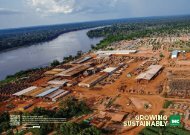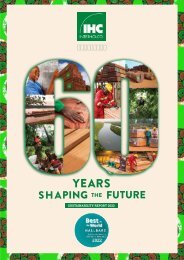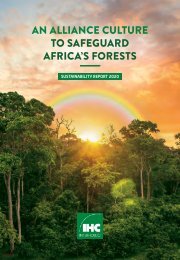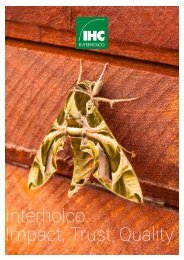Enabling Landscapes: INTERHOLCO's Sustainability Report 2017
Interholco presents its first stand-alone Sustainability Report simultaneously in Baar, Switzerland and in Vancouver, Canada, where the Forest Stewardship Council (FSC) General Assembly 2017 has just been kicked off. Interholco is an active participant at this General Assembly. To find out more: https://interholco.com/images/pdfs/Enabling-Landscapes-INTERHOLCO-Sustainability-Report-2017-.pdf
Interholco presents its first stand-alone Sustainability Report simultaneously in Baar, Switzerland and in Vancouver, Canada, where the Forest Stewardship Council (FSC) General Assembly 2017 has just been kicked off. Interholco is an active participant at this General Assembly.
To find out more: https://interholco.com/images/pdfs/Enabling-Landscapes-INTERHOLCO-Sustainability-Report-2017-.pdf
Create successful ePaper yourself
Turn your PDF publications into a flip-book with our unique Google optimized e-Paper software.
We harvest an average 0.5 trees per ha, equivalent to 1 football field,<br />
every 30 years. The minimum diameters by law would allow a harvesting volume<br />
of 10-15 m 3 . However, such a high quota would certainly lead<br />
to a much higher impact in the forest and possibly compromise natural regeneration<br />
and sustainable harvesting in future rotations. Actual harvest is below 10 m 3 .<br />
Reduced Impact Logging (RIL)<br />
The impacts of harvesting are<br />
only on 1/30 of the<br />
production area (i.e.: app.<br />
24'000 ha annually of 800'000<br />
ha total production area; app.<br />
300'000 ha are set aside and<br />
fully protected as HCV area).<br />
Harvesting is only carried out<br />
along carefully laid out skid<br />
trails. After harvesting, skid<br />
trails are rehabilitated to<br />
avoid permanent soil<br />
compaction. Harvesting<br />
roads are closed to avoid<br />
poaching and illegal<br />
settlements. Already after<br />
a few months, skid trails<br />
and harvesting gaps are<br />
overgrown by tree<br />
regeneration.<br />
Roads disappear after<br />
few years due to natural<br />
regeneration of pioneer<br />
tree species.<br />
Tackling climate change, using wood<br />
Using sustainably sourced wood products contributes to mitigating climate change.<br />
Of all building materials, wood is one of the few that sequesters significant<br />
quantities of CO 2 , a prime greenhouse gas. CO 2 is absorbed as trees grow, and<br />
stored in the finished product – potentially, for generations. Even better, where wood<br />
is used as a substitute for materials that require enormous energy to be produced,<br />
transported and processed, such as aluminium, steel, concrete or plastic, even more<br />
CO 2 is saved.<br />
56 SUSTAINABILITY REPORT <strong>2017</strong> INTERHOLCO
















